IMEHA (International Model Equine Hobbyists Association) was an online photo showing site that existing until 2018. Included on the site were these guidebooks for judging and showing model horses in Performance classes. MEPSA has obtained permission to share the info contained in the guides.
Coon Jump
Horse Racing
In-hand Jumping
Post Parade or Winner’s Circle
Camp Draft OZ – Mule Days – Open Show
Packing
Racing Standardbreds Under Saddle
Other Performance – Not Western or English
Polo or Mounted Team Sport
Steeplechase
Point to Point
Performance Using Pets To Help
Coon Jumping
Mules and donkeys have a sport all their own called The Coon’s Jump or Coon Jumping. It stems from hunter’s moving their mules through other people’s property. Wooden or stone fences could be taken down but wire ones can not. So the hunter would flag or cover the wire with his coat or a blanket and jump the string of mules over one by one. In the longear arena of showing, mules or donkeys jump a single rail standard with the height increasing in a jump off until the one who clears the highest jump is the winner. Some mules that are around 50″ at the withers have been known to jump clear heights of up to 72″ from a standing position! The jumps are not from a galloping approach but from a marked area of a box just next to the jump. The mule or donkey is allowed one step but most just leap from a stand still. The box is marked, the rail is covered with a saddle blanket or other similar size cloth. There are two different classes of Coon jumping, Saddled/Pack and Bareback. A halter is normally used in bareback. A halter or bridle may be used in Saddled/Pack. Stirrups should be tied up if a saddle is used. Jump must be a free standing jump with sliding knock-down-bar set up (cups or pegs facing away from animal) so to lessen chance of injury should animal not clear jump. The rider may stand in or out of the box and on either side of the jump or next to the side of the jump.
The attire is pants or levis, long sleeved shirt, boots belt, tie and cowboy hat. Even young stock and miniature mules or donkeys compete in Coon Jumping with much smaller jumps of course.
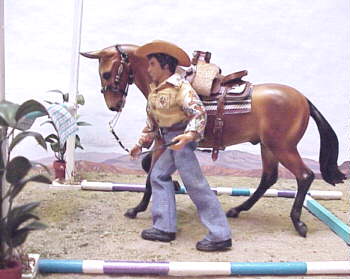
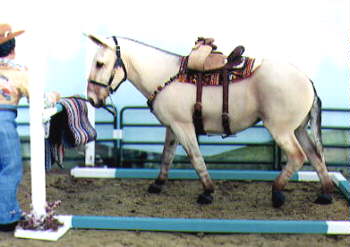
Horse Racing
This class is for all things pertaining to horse racing, except the post parade. Paramutual horse racing (open to TBs, AQHA, Appaloosa, Paints or Arabians premiums – no mix of breeds), backtrack meets, match races, fairground pony stakes sweeps, no hurdle competitions or harness racing allowed. Paramutual race horses should be wearing flat racing saddle with racing headstall and blanket with number. Backtrack, match or pony sweeps may wear any type light weight saddle and bridle as long as there are no tack that would cause harm to living animal. Paramutual jockeys wear silks. Other Riders wear any type attire but pants and boots are required.

In Hand Jumping
Premium open to any competition or training involving in hand jumping. Miniature horse shows, in hand trail course but may not cross enter same photo from in hand trail class, Training on longe line, etc. Premium requires tack on the horse, no free range entry.
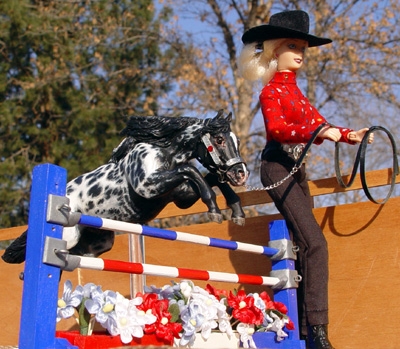
Post Parade or Winner’s Circle
Premium open the photo entry recreating a post parade racing scene or winner’s circle entry.

Camp Draft OZ – Mule Days – Open Show
Camp Draft comes in three different types. The best known in the Australian version. The riding style is like that of a combination of Western Riding, Cutting, Team Penning, and Ranch Sorting. In the competition, a rider on horseback must “cut out” one cow from the mob of cattle in the yard or “camp” and block and turn that cow at least two or three times to prove to the judge that they have the cow under control; then take it out of the yard and through a course around pegs involving right and left hand turns in a figure eight, before guiding it through two pegs known as “the gate”. The outside course must be completed in less than 40 seconds. There is a minimum of six head of cattle in the camp at any time with exception of youth class which there is only one. Tack used is an Australian stock saddle and a snaffle bit headstall. Riders waer long sleeve shirts, pant or jeans and hat or helmet.
This is another version of campdrafting seen at Mule Days for mules. Donkeys do not compete in this class. There is no cutting or penning work and the pattern is to push but not race head to head; a cow around a barrel. The mule may not pass the cow at any point and must turn the cow around one barrel and not lose control over the cow at any point. They may race behind the cow or next to the cow but not so far as to pass the cow. A Western saddle and bridle or hackamores are used. Leg protection is often seen. Attire for the rider is pants, boots, long sleeve shirt, cowboy hat and belt. Chaps are optionable. The third version is not seen often but found at fairs and play days where horses are entered in a stripped down version of campdrafting. The only requirement is to gain control of a cow once it is released into arena, normally from the roping chutes. Then to run the cow around a two barrel figure eight pattern. This version is a timed event with the fastest time the winner. Tack is a Western saddle and bridle or hackamore and attire is is pants, boots, long sleeve shirt, cowboy hat and belt.
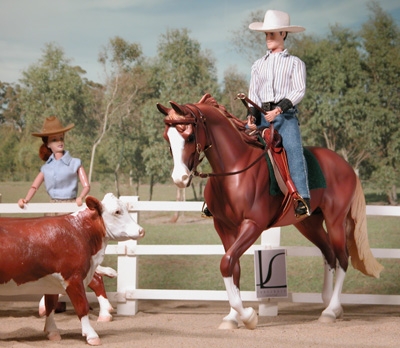
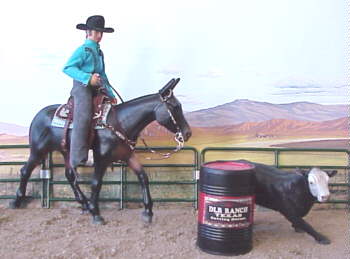
Packing
This class covers and type of packing other than Pack Thru Trail or Pack String Trail which competes in Miscellaneous Trail Events Section.
Pack Saddle may be either Cross Buck or a Decker. Photo may display the pack loaded with panniers and covered with a manta or as unloaded with just the frame showing. Pack harness must have a breeching which holds the harness in place.
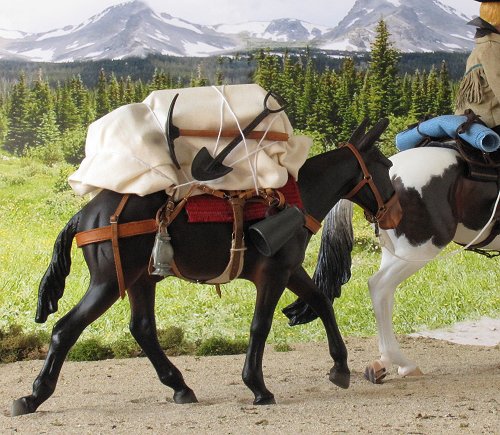
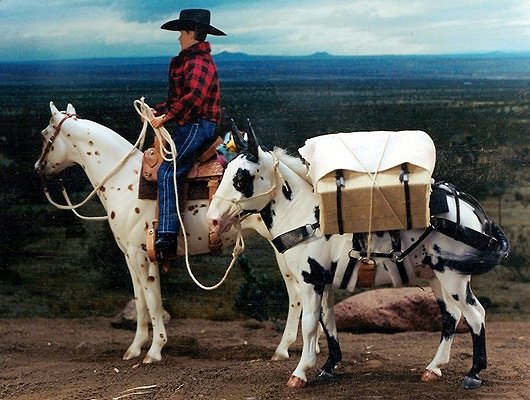
Racing Standardbreds Under Saddle
This class is for Standardbreds only. At one time it was very popular event and interest is now being renewed at fairs and harness race meet.
Required Tack:
Saddles:
Flat saddle, Thoroughbred Exercising Saddles, Close Contact, Jumping Saddles, or Eventing Saddles.
Bits:
Snaffle, Kimberwick, Pelham-Hybrid bit, Gag bit, Half cheek snaffle, Dr. Bristol-Half cheek snaffle, or Sliding Bit.
Added Equipment:
Tongue Ties, Drop nose band, Head Halter/Caveson, Mini-bit, Lip Cords, Over Check Bits Raymond Leverage, Racing Martingales, Standing Martingales/Tie Downs, Runners Mask, Shadow Rolls, Ear plugs, Hopple Hangers-Made of plastic and are used to hang the hopples on, Plain hopple hangers- two strips of plastic in the middle, breast plates, Knee Boots, Tendon Boots, Brace Bandages, Trotting Boots, Bell Boots, Scalpers, Crupper and the race number is attached to crupper
For more information check out RUSROA
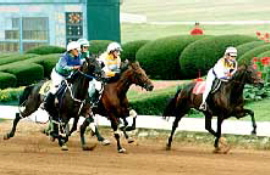
Other Performance Not Western or English
This class is the catch all for any entry than does not fit into the other classes. Premium requirement is limited only to entry not wearing a western or English tack or saddle.
Polo or Mounted Team Sport
Premium requirement for this class is any depiction of a regulation Polo entry or any mounted team sport.
Steeplechase
Premium requirement for this class is any depiction of a regulation Steeplechase. A jump of natural brush, hedge or manmade that of which is normally found in steeplechasing is required. The event takes place on a racetrack setting. Riders are professional jockeys wearing silks. Horses should be wearing flat racing saddle with racing headstall and blanket with number. Leg wraps or boots are permitted. A racing breastcollar is commonly used. The horses are registered Thoroughbreds.
Point to Point
Premium requirement for this class is any depiction of a regulation Hunter Point to Point. A jump is required in the photo. A point to point is a form of amateur horseracing over fences for hunting horses in Ireland. Historically it is opened to only Thoroughbreds however in recent years, pony racing has been staged at British meetings in an attempt to encourage more young riders into point to pointing and national hunt racing. The IMEHA Point to Point class is open to any horse breed. Most point-to-point courses are on ordinary farm land, although some courses are placed on the inside of professional course. Every course must have a minimum number of 18 fences and at least 2 fences must have ditches. Fences for ponies are 2’6″ to 3′ high. Tack is English Jumping style tack, or flat racing saddle with surcingle. Attire is steeplechase or horse racing style silks. Youth must wear a helmet. Horse must wear number cloth. Whips, and leg protection or boots are optional. Either a racing breastcollar or a neck strap is commonly used.
Performance Using Pets To Help
Premium requirement for this class is any depiction of an event in wear an animal of some type other than cattle or horse assists in the rider in completing the subject matter. An good example is a dog helping (exception is foxhunting) to pen cattle or other loose animals. Barnyard animal helpers, chance meeting of wildlife creature that may assist the rider in some manner or other household pets working with a horse themed recreation are other examples.
